By Theme
Discover the coins that built the British Empire
The East India Company is living proof of Sir Walter Raleigh’s (1614) prophetic words: “whosoever commands the sea, commands the trade, whosoever commands the trade of the world commands the riches of the world and consequently the world itself,” as they rapidly became a trading force to be reckoned with.
And coins were one of the key ways the company managed trade across the globe.
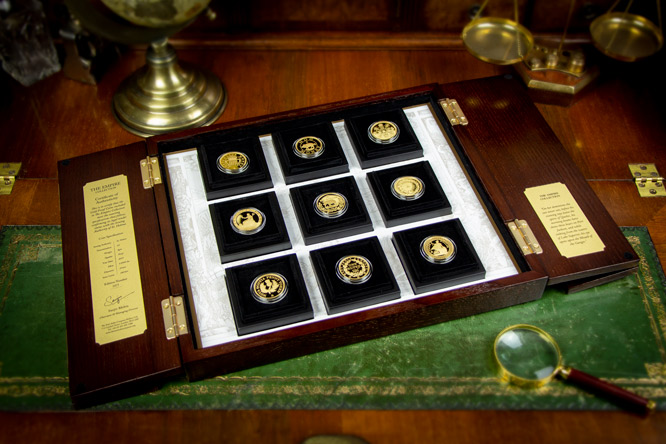
At its peak the EIC was single-handedly responsible for half the world’s trade, including cotton, silk, spices, opium and tea.
Remarkably, the East India Company is still trading today. And they have just authorised a set of limited edition Gold coins paying tribute to the most important coins in their history.
Here is the story behind the coins…
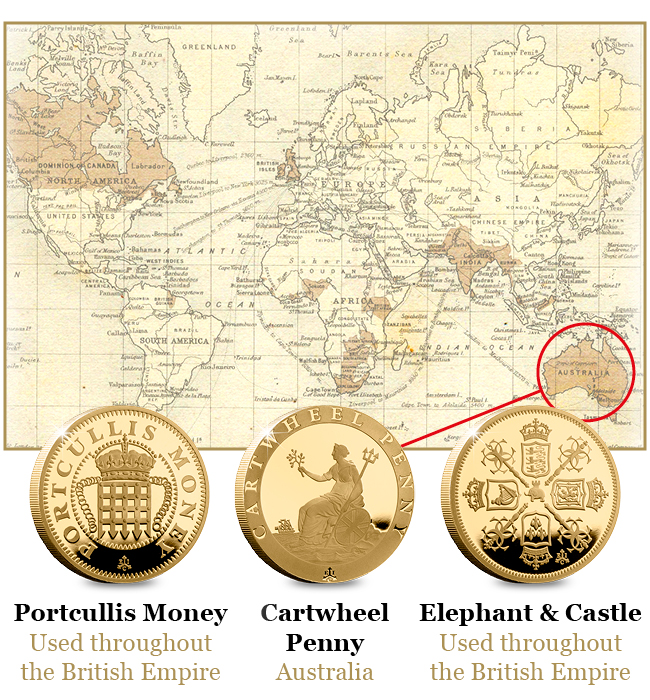
Portcullis Money – 1601 (Throughout the Empire)
Ordered by Queen Elizabeth I to facilitate increased commerce on behalf of the British Crown and to compete against the widely used Spanish Real. These were the first coins issued for the British Empire outside of England’s normal coinage.
The Cartwheel Penny – 1797 (Australia)
The Cartwheel Penny was the first British coin to be exported to Australian Colonies. It was introduced to help curb Britain’s chronic coin shortage which was impacting economic growth. Specially designed to prevent counterfeiting, and the thick rim and inscription led to the pennies being informally named ‘The Cartwheel Penny’.
The Elephant and Castle Guinea – 1663 (Throughout the Empire)
The guinea is regarded as the most successful trade coin, exponentially increasing British and local trade wherever it was introduced. This Guinea was the first British machine-struck coin, and adopted its name from where the gold was mined from.
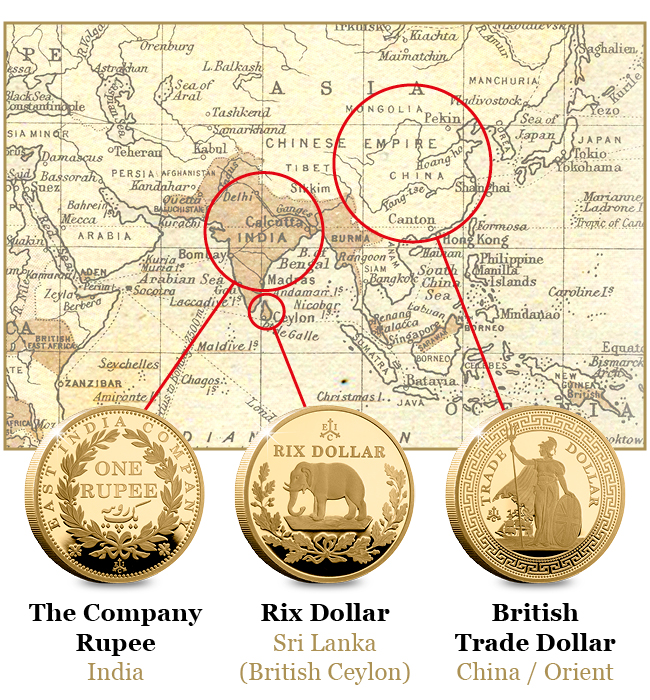
The Company Rupee – 1833 (India)
The Rupee is one of the world’s oldest systems of money. It was adopted by the East India Company upon its arrival in the East, and soon became one of the company’s most important coins and means for trade. In 1833 reforms to the Indian weights and measures led to coinage in India changing from the Sicca to the standard ‘Company Rupee’.
The Rix Dollar – 1821 (Sri Lanka)
Great Britain sought to develop Ceylon’s (Sri Lanka’s) economy and increase trade to and from Europe. As a part of this aim The Rix Dollar was struck specifically for use in Ceylon. Designed by Benedetto Pistrucci, who is also responsible for the now iconic rendition of St. George slaying the Dragon which features on British Sovereigns.
The British Trade Dollar – 1839 (The Orient)
To facilitate the trade of their most lucrative commodities, namely tea and opium a trading post in Canton, China was established. During the Trade Wars Great Britain found itself having to rely more and more on its own silver coinage, and this paved the way for one of the most distinctive silver British coins in numismatic history to be struck: the British Trade Dollar.
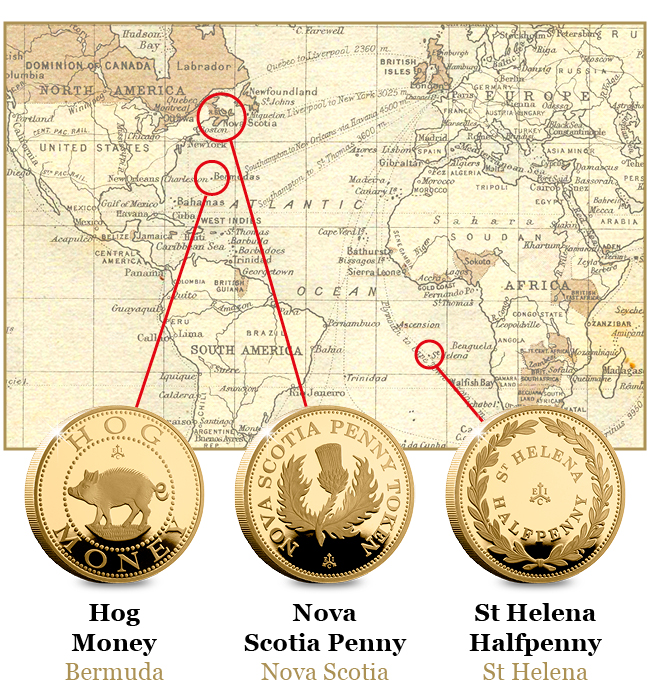
Hog Money – 1609 (Bermuda)
In order to develop Bermuda’s prosperous economy King James I granted permission to mint coins, which resulted in the issuing of Hog Money, inspired by the wild hogs previously introduced to the island, it’s the first English coin to be minted specifically for use in North America.
The St Helena Halfpenny – 1821 (St Helena)
In 1815 St Helena’s economy benefited from the arrival of the former French Emperor, Napoleon, during his second exile, as the famous prisoner brought with him an entourage of British troops, effectively doubling the islands population and prosperity. As the economy swelled, St Helena’s first local coins were introduced.
The Nova Scotia Penny – 1823 (Canada)
Prior to the Canadian Confederation in 1867 many provinces issued their own coinage. However in 1823, without seeking official approval from the Home Office, the province of Nova Scotia ordered the issuing of coins. The coins, issued in denominations of one pennies and halfpennies, contributed to the expansion of local commerce in Nova Scotia.
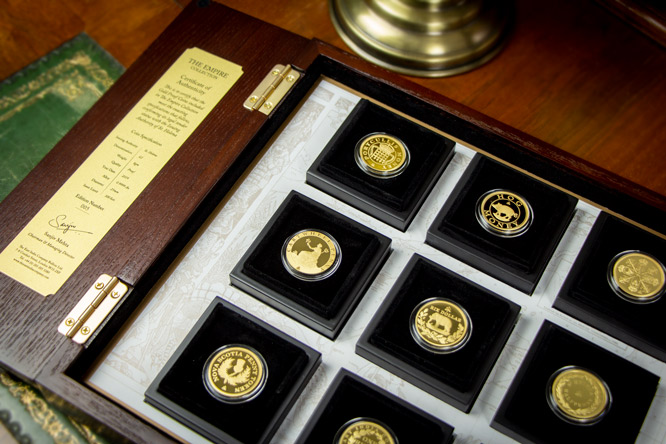
The 2019 Empire Collection
For this exceptional 2019 issue collectors will be taken on a journey to the far flung corners of the world. Retracing the steps of the East India Company, to discover some of the most significant coins which have helped build an empire stretching across three centuries from 1600 to the Victorian Era.
Finished to an exceptionally high standard, the 2019 collection truly represents the global resonance of The East India Company and these significant coins. There is no doubt the 2019 Empire Collection is going to become a future collector priority.
If you are interested…
Out of a Worldwide edition limit of just 100 we have a small stock of the 2019 Empire Collection available. If you are interested in owning a set – please complete the form below and we will contact you directly.
The life and reign of Queen Victoria told through her coins…
One of the things I find most interesting when collecting historic coins is the insight they give into the time they were struck and of the monarch who issued them.
A particular reign that has always fascinated collectors is that of Queen Victoria. During Victoria’s long reign only three major obverse portraits adorned her coins and they come together to chart the life and reign of one of Britain’s most popular monarchs.
The Young Head
The first effigy to feature on Queen Victoria’s coinage is known as the ‘Young Head’ portrait. This early portrait shows Victoria at the tender age of just 18, when she acceded to the throne.
The public in the early 19th century would not have been aware that the youthful Victoria depicted on their coins would soon become the leader of the largest Empire the world had ever seen and would reign longer than any British monarch before her.
The ‘Young Head’ portrait was extremely popular with the general public and remained on Victoria’s coins with only minor alterations for the majority of her reign.
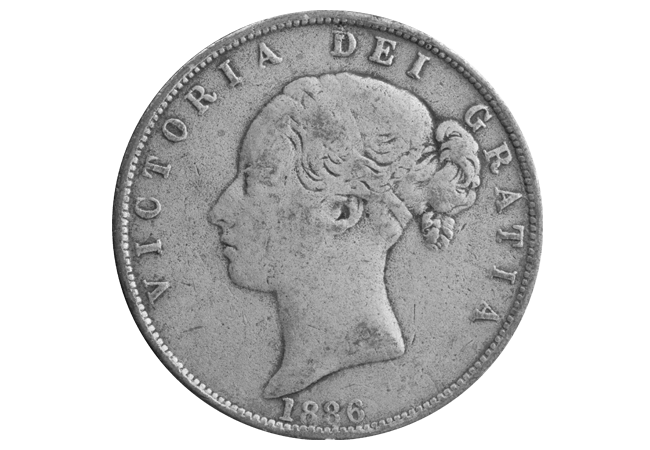
The Jubilee Head
After 60 years however, it was decided that a new portrait was necessary to reflect Victoria as the elder stateswoman she had become. Victoria’s Golden Jubilee marked the occasion for a design change and Joseph Edgar Boehm was chosen to design a portrait for the 78 year old Queen.
However, Boehm’s portrait failed to gain the public’s admiration in the way its predecessor had. The portrait was met with ridicule by the general public who found the small crown balanced precariously on her head as unrealistic and almost comical.

The Veiled Head
The ‘Jubilee’ portrait was quickly replaced in 1893 after only six years, with what was to be the final obverse used on Victoria’s coinage. This new effigy was designed by Thomas Brock and shows a mature bust of the Queen with a veil representing her long period of mourning after the death of her husband Prince Albert.
Victoria was deeply attached to her husband and she sank into depression after his death. For the rest of her reign she wore black and the final portrait of the highly respected Queen represents this secluded period of mourning that came towards the end of her life.
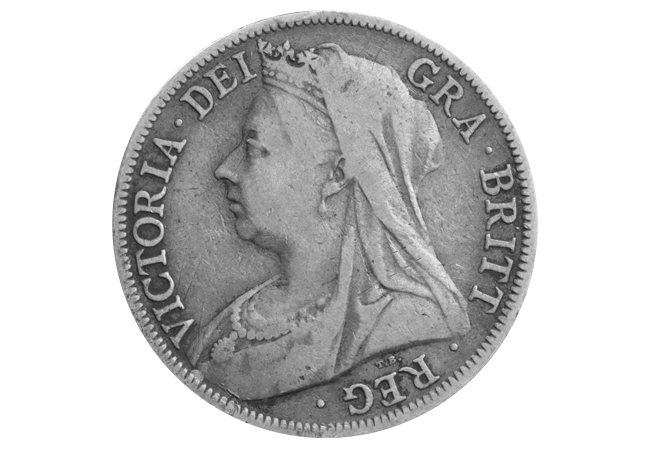
Together, these coin portraits tell the story of Queen Victoria, with each marking an important period from her long reign. All of these coins are now over 100 years old and for me they epitomise Victorian coin collecting.
_______________________________________________________________________________________
If you’re interested…
Today, just a handful of collectors have the opportunity to own each of these key portraits in the official Queen Victoria Half Crown Set.
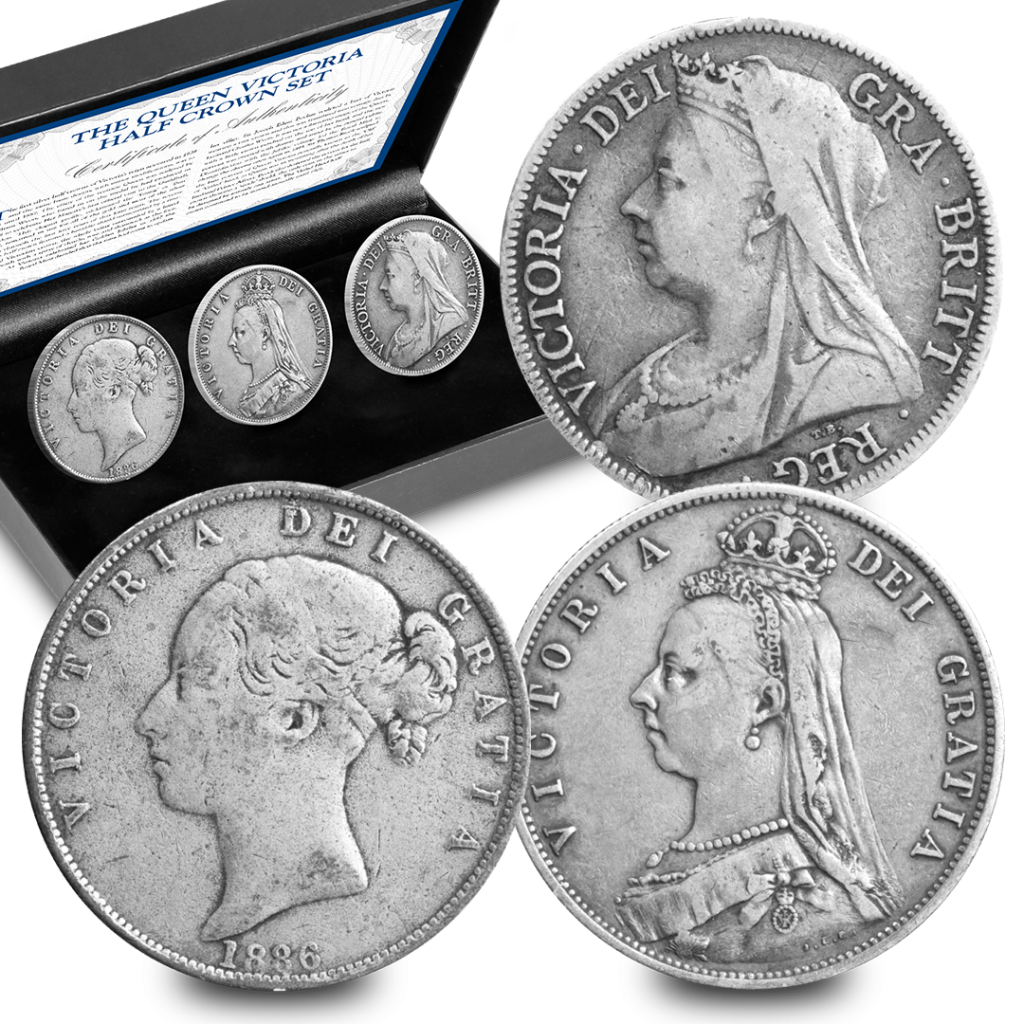
However, these historic coins are very difficult to source and we only have a limited number available.
Click here for more details >>
The day I took 800 coins to the sky in a WWII Spitfire
Last Saturday I had the opportunity to see the RAF’s most famous plane up close and personal. That’s because on the 24th March I drove up to the historic Duxford Aerodrome to have 800 of the brand new Spitfire £2 coins flown in an original WWII Spitfire.
I arrived at 9am but unfortunately the chance of flying was in doubt because of the poor visibility caused by low lying clouds. The rest of the morning was spent nervously looking at the sky waiting for enough visibility for the pilot to safely take the 74 year old warbird into the air.
Our pilot for the day was Flight Lieutenant Anthony Parkinson MBE, known as Parky. The delay caused by the weather gave me the opportunity to talk with Parky about his time in the RAF and how the Spitfire compares to the modern jets he has flown during his time with the RAF. You can see Parky discussing his career and the Spitfire in the video below.
The wait for take-off also gave me the opportunity to sit in the cockpit of the famous fighter plane and experience some of what it would have been like for the young pilots who sat in the same cockpit to defend Britain in the skies over 70 years ago.
Finally at 2.00pm the cloud cleared enough for a small pocket of visibility to take the Spitfire into the air. We quickly pushed the Spitfire out of the hanger and Parky secured the 800 Spitfire £2 coins into the wing bays which would have once held the plane’s armaments.
At 2.20 Parky prepared the plane for take-off. Standing a few yards from the plane whilst it’s famous Rolls Royce engine fired up was brilliant, and the Spitfire TD314 drew in a crowd nearby while it taxied along the runway.
Parky swiftly took the famous plane into the sky and gave me and the rest of the crowd a fly by. Despite the cloud cover it was still fantastic to see the Spitfire race through the sky at the hands of a former Red Arrows display pilot.
The brand new Spitfire £2 coin is a fantastic commemoration of the famous plane and I am grateful that I had the opportunity to mark the 100th anniversary of the RAF with such a fitting tribute.
Thank you to Ben Perkins, Flight Lieutenant Anthony Parkinson MBE and the rest of the team at Aerolegends for helping to take the Spitfire £2 coins to the sky and for giving me the opportunity to see this famous warbird in the flesh.

Signed edition Silver Proof £2 Spitfire coin.
If you’re interested
All 800 coins have now been sold. However, we will soon be flying the 4 times as limited ‘signed edition’ Silver Proof £2. Click here to pre-reserve yours now >>
